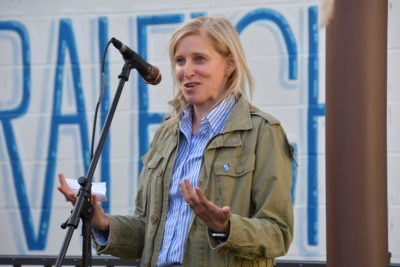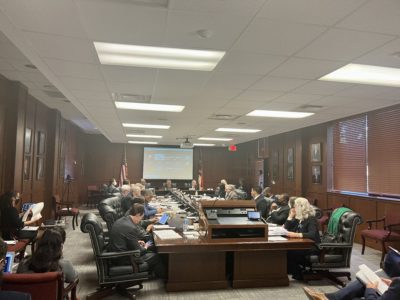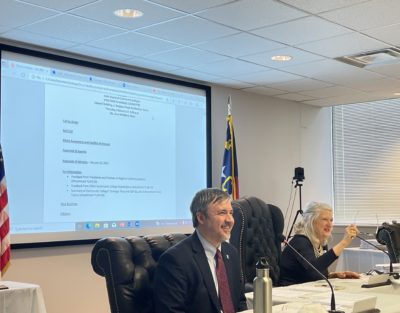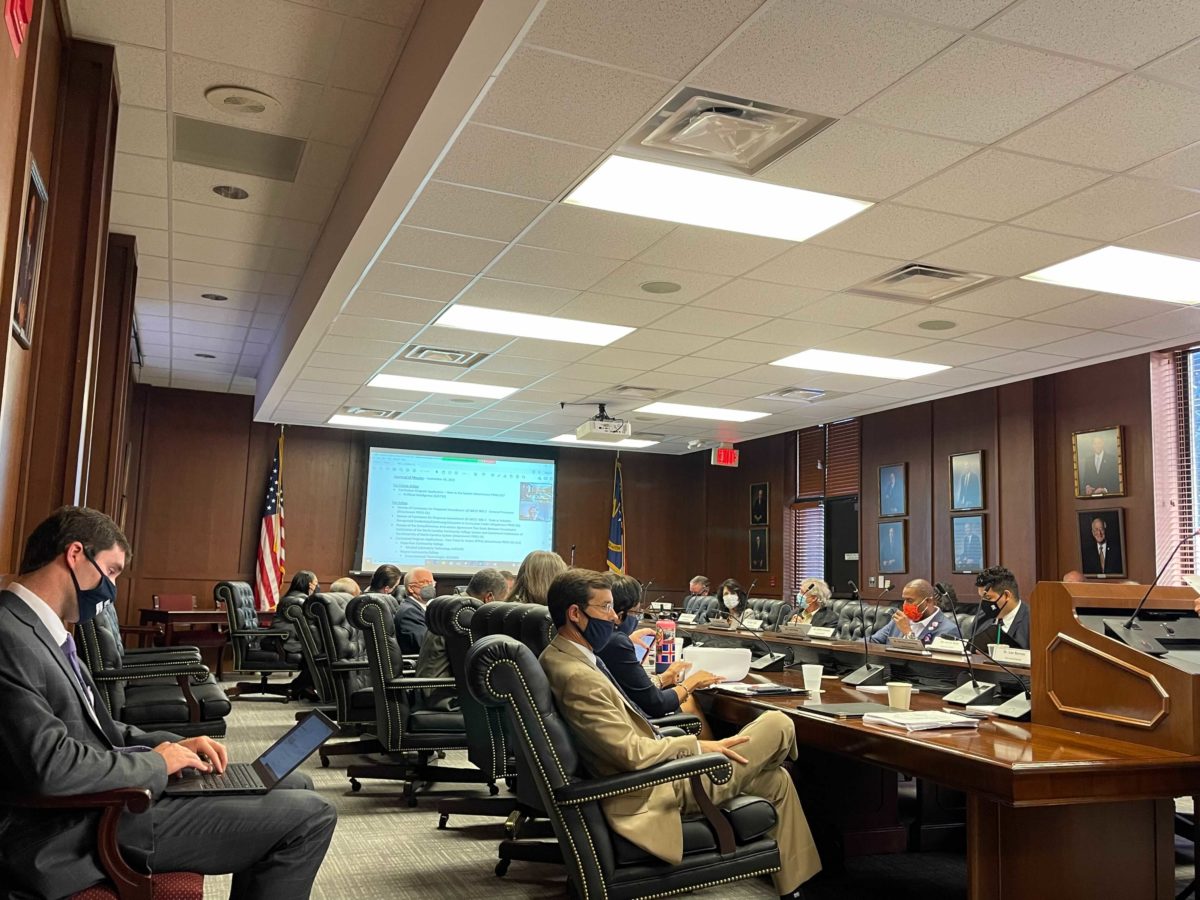

Share this story
- “There’s a lot to reflect on,” Board Chair Burr Sullivan said. “I’m glad we have a capable Board that’s willing to roll their sleeves up, sit here for 4.5 hours, and do the work of our students.”
- “My total focus is on student success and to provide a system office and a college system that provide a vehicle of higher education,” said @NCCCSPresident in a virtual presentation to the State Board of Community Colleges.
|
|
The North Carolina State Board of Community Colleges continued its self-evaluation process last week, approving a set of recommendations for the second phase of its three-year development and engagement plan at its April 22nd meeting.
The three primary recommendations established: a process and schedule for annual evaluation and goal setting for the system president, a stronger framework for Board engagement in the system’s strategic plan, and an increased understanding of the role and mission of the Board. The approval of those recommendations followed the Board’s development of five goals for the system president in March, during a closed-session meeting that lasted more than three hours.
“There’s a lot to reflect on,” Board Chair Burr Sullivan said. “I’m glad we have a capable Board that’s willing to roll their sleeves up, sit here for 4.5 hours, and do the work of our students.”
The Board identified a need to set goals for the system president last December and January. Around that time, the Board also held a one-year review of North Carolina Community College System (NCCCS) President Thomas Stith at its January meeting.
In February, the Board approved its first self-assessment survey, which was conducted in March. The purpose of the survey was to help identify system, Board, and president goals to weave into the system’s four-year strategic plan.
The policy and governance committee drafted the recommendations based on the self-assessment results. There was broad support for a more meaningful partnership with the president and system office among Board respondents, the committee said in a report of its recommendations. That approved process includes a timeline for annual goal setting, quarterly meetings, and a year-end evaluation. In addition, the system president will provide updates on annual goals at monthly Board meetings throughout the year.
During a lengthy discussion, multiple Board members said they wanted more clarity regarding the vision of the Board. Other members expressed a desire to see the Board’s bylaws edited to provide more guidance on communication with the system office, and for currently absent items, like terms for removal of a Board member.
The Board also adopted six other related recommendations:
- Establish a new curriculum for onboarding Board members, in collaboration with the system office, and develop a Board handbook. At the end of Friday’s meeting, Sullivan said a 13-page handbook regarding common acronyms used by the Board was available.
- Review, evaluate, and revise, as needed, bylaws to ensure that they provide comprehensive and adequate guidance to support the Board’s actions and decisions. Bylaws should clearly outline governance and authority levels, rights, and expectations.
- More Board control over the meeting agenda “to support Board review and discussion of substantive System issues, facilitate strategic decisioning, and enhance oversight of the System’s achievement of defined priorities.” Board members said this might require revision of the Board’s bylaws. Though such changes would be time-consuming, Board members said hopefully the revisions would streamline the meeting process moving forward.
- Review the structure, mission, and process for Board committees. This would include refining current committees, redesigning committee agendas, and assessing if additional committees or work groups are needed in the future.
- Create a process for establishing new committees. (Some members mentioned marketing and communications for initial consideration.)
- Re-introduce informal Board dinners to take place during monthly meetings. Sullivan said dinners were scheduled for meetings starting in August.
“We look forward to this evolution continuing and making us a stronger Board,” Sullivan said. “This is the only way we get better — to question things and look at our structure and how we go about the business of the Board. I’m very encouraged about all this.”
President Stith’s report on five new goals
President Stith virtually presented his first monthly presentation regarding the Board’s goals on Friday. After his presentation, Stith stressed this was the start of the process.
“How do you meet these goals?” he asked. “Which we will do — we just have to prioritize how we go about it.”
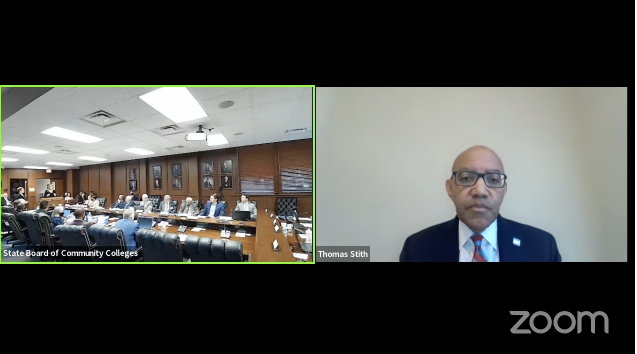

Stith provided updates for each of the five goals developed by the Board at its March meeting:
1. Enhance team building, internal communications, and leadership development to improve hiring, retention, turnover, and morale.
Stith spoke about the importance of retention and recruitment efforts across the system. He said his team established an employees relations committee to help understand concerns among staff.
He also plans to launch a monthly newsletter for system staff to increase his communication with them. In addition, Stith will continue to review the climate survey results (read below for more) to implement recommendations.
2. Strategy to enhance regular communications with presidents, Board members, and legislators to inform them on the activities of the system office.
Stith said the need for improved internal and external communications was a consistent theme in the organizational process. In addition to creating the monthly newsletter, Stith said he will continue visits with college presidents and legislators to help meet this goal.
3. Frame a plan in collaboration with community colleges to address enrollment declines that promotes best practices and initiatives.
“This is our first priority — it is my first priority, I can say that,” Sullivan said. Stith highlighted the following current activities across the system to address enrollment:
- The Strategic Enrollment Management (SEM) Taskforce, which was created in 2019 to help colleges better understand enrollment management and is made up of system office staff and individuals from community colleges across various departments. The enrollment analysis for participating colleges is expected in December 2022, Stith said.
- N.C.’s Reconnect adult learner pilot, which is bringing on its second cohort of five schools this spring.
- The Racial Equity for Adult Credentials in Higher Education (REACH) Collaborative, a national initiative focused on helping Black, Hispanic, Latino, and Native American adults earn credentials, in partnership with the Lumina Foundation.
- Marketing efforts for the expansion of the Longleaf Commitment Grant to 2022 North Carolina high school graduates.
4. Identify administrative and programmatic changes, including collaborations and reduction of red tape, to better support our colleges based on feedback from the presidents that was provided during listening sessions.
Stith said he wants to help encourage regional partnerships. At the end of Stith’s presentation of this item, Sullivan said he’d add incentivizing financial collaboration between colleges, so that one college doesn’t shoulder the burden of a partnership.
5. Establish a platform for identifying and developing initiatives to support the stabilizations and advancement of rural colleges in light of the demographic and funding challenges that many of them face.
Stith specifically highlighted projected population declines at rural areas in the future. He highlighted the system’s investments in rural broadband, workforce training pipelines, and student success centers, as well as the Rural College Leaders Program led by the Belk Center for Community College Leadership and Research in partnership with Achieving the Dream. Moving forward, he proposed working toward increased shared services at colleges supported at the system level.
Goals 3-5 are longer-term goals, Sullivan said, adding that the Board asked Stith to come back in July with a deeper dive on those goals.
“Today was just how we get our arms around how we approach solving those,” he said.
Board member Ray Russell asked Stith to elaborate on who he wants to be as president — rather than providing a list of things he wants to do.
“My total focus is on student success and to provide a system office and a college system that provide a vehicle of higher education,” Stith said. “And so as I look at my service as president, that’s what I’m focusing on. … I’m measuring how we are impacting the lives of our students.”
Board members thanked Stith for his report and asked for continued feedback on how realistic the goals are.
Sullivan and Stith both said Friday’s meeting was the start of a long process.
“We expect to be talking about these goals every month until they’re accomplished,” Sullivan said. “We do expect to create some metrics and the president alluded to some deliverables in his remarks, but we’re just starting this process and there’s a lot of work left to do on it.”
Under the new process for presidential evaluations approved by the Board, moving forward the Board will review and update its evaluation process each August for the following fiscal year. In September, the system president will share a self-evaluation with the Board. A presidential evaluation and goal-setting process by the Board will take place in October, to be discussed in November and December. By January, the president will share their annual goals with the Board.
Organizational and climate surveys
In addition to its self assessment, the Board also previously approved a $6,000 contract with training organization TaylorTrain to conduct a climate survey among community college system office staff. The Board received a summary of those results last week, Sullivan said, but doesn’t plan to present a public version of the findings.
That climate survey is in addition to the organizational assessment launched by the system office in December 2021 and conducted by CampusWorks to ensure the system office is properly resourced to meet its vision and mission. CampusWorks presented an overview of its findings to the Board on Friday.
The assessment included five stakeholder insight surveys with 257 respondents and a review of more than 50 documents. CampusWorks also hosted 21 employee focus groups with 12 one-on-one interviews to complete the assessment.
“What makes you so unique is that you’re unparalleled in the reach that you provide,” CampusWorks Chief Executive Officer Liz Murphy told the Board. “North Carolina citizens do not have to go far to find a community college. The question is: Will they find all the services they need when they get there?”
CampusWorks said the strengths of the NCCCS are its performance compared to other state community college systems, its talented employees, and the breadth and depth of programs and services. Moving forward, the assessment recommended an increase in staffing and resources for the system.
CampusWorks also recommended clearer messaging regarding how the system directly supports the success of its 58 community colleges.
New strategic plan
The system’s strategic planning committee provided a brief update on the system’s new four-year strategic plan.
In February, committee Board members identified the following top five issues for the strategic plan: supporting top-quality faculty/staff, expanding education/training pipeline, boosting student success for all, addressing employer needs/talent development, and improving system funding effectiveness.
Since then, the committee formed a team for each of the five issues. Each team is comprised of two community college presidents and one Board member. There will be three live streamed meetings for each team, with the first meetings starting this week.
Following President Stith’s report, Board member Sarah West cautioned against setting up three different measurements through its surveys, presidential goals, and strategic planning.
“And a lot of these problems are old systemic issues that have been inherited to a certain extent,” she said, “and so when you start to activate systemic change, there’s always the challenge of scaling your capacity as a system office to meet the renewed enthusiasm and demand.”
Patrick Crane, NCCCS vice president of strategic initiatives, echoed West.
The recommendations from CampusWorks fit well with the Board’s first two internal goals for the president, he said, and the strategic plan with goals 3-5.
“It only makes sense for us to move forward with these aligned together,” Crane said. “And the strategic plan, and the work that the Policy and Governance Committee has done with the President’s goals — I think there is tremendous alignment already.”
Interim president at Johnston announced
During the personnel committee’s report, Chair Bill McBrayer said the committee selected Dr. Ken Boham as the interim president at Johnston Community College (JCC).
David Johnson, who has been the college’s president since 2009, announced his resignation on April 15, effective May 15.
“After serving as JCC’s president for the last 13 years, it is with mixed emotions that I announce I will be stepping down from my position May 15, 2022,” Johnson said. “While I am excited to pursue new opportunities ahead, I am able to look back with satisfaction on the work we have done together to chart a pathway to success for the thousands of students who have benefited from JCC’s educational programs.”
Boham will start on May 16, according to a JCC press release. He served as the president of Caldwell Community College and Technical Institute for more than 20 years.
The personnel committee also recommended the approval of three additional cybersecurity positions.
The General Assembly allocated $1.49 million in the most recent state budget to hire nine IT security and compliance manager positions. The pay for each of the positions starts at $110,000. There are now only three vacancies remaining.
Work to define HyFlex to continue
In response to pandemic-related challenges, the programs committee presented a new definition to the Board concerning types of curriculum last month — “hybrid flexible (HyFlex)” instruction. The definition was approved by the Board, which was set to adopt the definition at this month’s meeting. The HyFlex option joins traditional, online, hybrid, and blended instruction.
Instead, the Board decided in a special vote to extend the public comment period for the definition through July, with plans to adopt a definition at its August meeting. If the definition is not approved then, the process will have to start over.
This decision followed feedback from community college presidents that the proposed definition would create challenges for teachers. The definition approved by the Board in March was different from the one originally presented to colleges due to data entry concerns, the programs committee said.
Amanda Lee, president of Bladen Community College, spoke on behalf of the North Carolina Association of Community College Presidents (NCACCP) at the meeting.
“We as presidents absolutely don’t want to get in the way of student success and student completion, and we’re very excited about the HyFlex definition being presented and flexibility,” Lee said. “Where we would like to pause is when the definition changed, our understanding of how to implement this definition has also changed. We all want to be able to do something. As you just heard with the way the definition is written now, a lot of schools are not going to be able to be as flexible as we all want to be because of other limitations.”
The schools piloting the new definition will still do so starting in August. The Board said its new goal is to have a definition in place in time for other colleges to implement in the spring semester.
HyFlex is currently defined as: “College curriculum courses in which 100% of the instruction is offered face to face with the instructor in a physical classroom and 100% of the instruction is offered online allowing students an opportunity to choose whether to attend classes during regularly scheduled in-person sessions or participate online synchronously or asynchronously.”
The new definition will allow the system to “meet students really uniquely where they are, as it relates to being able to use online learning in a different way,” programs committee chairperson Bobby Irwin said in March.
The State Board will meet next May 19-20.



